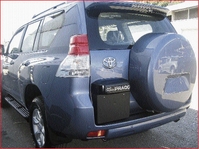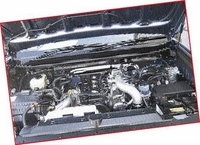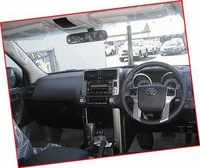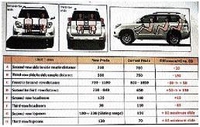
The muscular Prado derrière push-button tailgate opens out, not up. This might be inconvenient. - Photos by Mario James
By the time you've reading this, the flashing bulbs will have popped, the champagne gone flat, the sound boxes unplugged and the polite banter of fully 1,600 of Jamaica's elite died down to a mere whisper in some journalist's fertile mind.
Toyota's new look Prado was launched Thursday last. Predictably, Toyota's mid-level offering has engendered a lot of interest. Among politicians and those who travel in those circles, Prado has created a cult following. It had the looks - and the options list - to set it apart from the mainstream, with excellent mileage figures and a low-carbon footprint, so important nowadays.
This new Prado continues that trend - with a few more high-zoot 'whatsits' to add to the options list. But first, let's talk about what hasn't changed. Suspension layout is the same - double wishbone front and rear with a torsion bar panhard rod five-link rear live axle set-up. Low tech, but proven.
The VIGO pickup's front-end parts can literally be put under this truck. Since the overhaul of that vehicle's spring and damper rates were recalibrated last year - which improved the ride from washboard stiff to pleasantly pliable - we approve (in theory, we haven't driven the truck - yet!).
Also carried over from the pickup platform is the venerable 1KD four-pot turbo diesel-power plant, in both 3.0- and 2.7-litre flavours. (A staffer told this reporter that the 2.7-litre offering in this platform is a bit of a dog - so prospective buyers might want to stay away from that config, especially if you want to climb a hill at more than pottering rates of go. (So mi get it, so mi gi yuh).
Rated at 170 horses at 3,400 rpm, with at least 350 lb/ft of twist available from 1,600-2,800 rpm - the ol' intercooled 1KD still has some life left, especially since it has been detuned to live with Jamaica's high-sulphur fuels. However, the astoundingly high 19.1 CR - high for any vehicle with a turbo - makes this reporter wonder what they did. Manufacturer-published efficiency figures aren't really published by Toyota for this market - but the combined l/100km figures overseas say the three-litre engine in the new body sips gas oil to the tune of 9 litres/100 km - which works out to about 26 mpg, which ain't too shabby.
Prado sheet metal has received more than a few tweaks to bring the best-selling SUV in Jamaica more in line with the corporate look - the headlights are no longer flush with the body work, and the look is now definitely glacier-like - fitting with the lenses of its other stablemates.
The grille is also more vertical than last year's with six, not seven, vertical bars. The grille is also not ingrained into the bonnet, and is now fitted with gas struts - no more prop rod! Woohoo! The hood is now completely flat - no water-channelling ridges or pedestrian locating centre line exists (purportedly used by political chauffeurs in OTHER SUVs to mow down insurgent constituents. Line 'em up, feel the double bump, then off to Cabinet! All in a day's work, eh Minister?)
The Prado beltline also has changed: The wheel wells aren't defined by plastic frippery anymore. They are more pronounced and made of METAL. The third-row window now has a more pronounced sawed-off edge than the outgoing model, and the tail light also has the same frozen ice cube upon frozen ice cube treatment as the front.
But the overall silhouette has not changed. In fact, if one were to look at both new and old models travelling at the new Prados' rated speed of 175 km/h, one would be hard-pressed to tell them apart.
There are five Prado trim levels, two rim choices and eight new colours and black. Base is the TX - no LCD screen, only fore and aft power on the front seats, 17" alloys, parking sensors front and rear and push-button start, which is now standard from the base model. This feature also extends to the tailgate, which can be opened with buttons on the outside of the car so long as the key fob is on one's person.
Bluetooth accessibility

Along with a few front-end parts, the Prado shares the 1kd engine with the VIGO pickup.
However, the tailgate opens out, not up, which means if a car is parked too close to the rear, grocery access becomes an issue. Opting for the spare tyre carrier underneath the car enables access through the back window. The base also comes with hard-wheel cover, rear spoiler and indicators in the wing mirrors. The next step up is TX-mid - the leather package - and then comes TX-high, with sunroof. All Prados now come with full Bluetooth accessibility, Engine Immobiliser, 'conver-sation' and anti-glare rear-view internal mirrors and 265/70/17 tyres are also standard.
The VX option level gets you some serious toys: 18" rims, a cooler box between the seats, 4" LCD with reversing camera and a system called KDSS, which is Toyota's technical tour de force. The acronym stands for Kinetic Dynamic Suspension System. It's a load levelling hydraulic system, which behaves like your favourite California Low Rider, but with purpose.
With a hydraulic actuator at each wheel, the ride height at each corner is now controllable. This adds a few miles an hour to the slalom speeds, but, more important, it adjusts pitch, yaw and roll during panic stops from high speeds. SUVs without this system, with their high centre of gravity don't handle this manoeuvre very well, tending to roll over quite venomously if any evasive tactics are employed during such an event. Vehicle safety is then much improved and is something Toyota can take a bow for.
multi-terrain monitor

Typical Toyota interior: large flat expanses, good materials throughout. Purposeful.
The VX-L comes with a four-gimballed camera multi-terrain monitor - so that Prado drivers can view the terrain without coming out of the vehicle - two in the side mirrors on fore, one aft. It also comes with steering-angle indicator and five-speed crawl-control capability.
The final question is cost: The base TX starts at $7m, and each rung up the trim ladder adds a staggering $600K to the base. The top-of-the-line VX-L drives off the showroom floor for the princely price of J$10m. For those who can dial their way into a VX-L, this unit should be able to challenge - on paper at least - the Pajeros on one end and the BMW X5 and Merc M Class on the other, based on Toyota's VSC (Vehicle Stability Control) - coupled with KDSS, which is a real worthy feature.
Off-road prowess, though, is more about vehicle design than electronics, so we'll see what happens with the road test that is sure to follow.

mario.james@gleanerjm.com